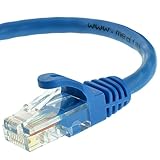Ethernet Cable vs. LAN Cable – How do they differ?
Ethernet cables are basically a part of the wide range of LAN cables. They are mostly used in computer networking and are ideal for fast transmissions. Are there any differences between the two?
With the increased development in technology, more and more terminologies are coming up by the day. It may be quite difficult to keep up, especially since the changes come so fast. The words ‘Ethernet cable’ and ‘LAN cable’ are thrown about constantly, and it is only expected that some people may get confused. So what sets them apart?
The first thing you should know is that LAN consists of a wide range of cables that are responsible for transmission of power or data from their sources to different devices. Ethernet cables and LAN cables are a part of a collection of cables called Network cables.
Here is a comparison of their characteristics.
Table of Contents
What is the difference between Ethernet cables and LAN cables?
Cable |
Ethernet Cable |
LAN Cable (Winner) |
Functionality |
Computer networking |
Connecting devices to sources of power and network |
What is the difference between Ethernet and LAN cables?
Functionality
Ethernet cables are essentially cables that are used for transmission of data in the form of electromagnetic impulses. They have varying standards that give them different characteristics. Their speeds range from 10/100Mbps to 10Gbps and they are categorized as shielded and unshielded.
LAN is an assortment of cables that connect devices to their sources of network. Some LAN cables include fiber optic cables, patch cables, twisted pair cables and coaxial cables.
Ethernet Cable vs. LAN cable Overview
Ethernet Cables
- CAT6 / CAT5e: Supports both Cat6 and Cat5e applications. The RJ45 connector used for this cable fits...
- CAPABILITY: Mediabridge Cat 6 cables can support up to 10 Gigabits per second (10 times the bandwidth of...
These cables are responsible for the transmission of data from routers to computer devices. There is quite a variety of them and they differ in their transmission speeds, bandwidths and shielding. They are also used for relatively short distances that many times do not exceed 100 meters.
Some Ethernet cables that are commonly used are the Cat5, Cat5e, Cat6, Cat6a, Cat7 and Cat8 Ethernet cables, where ‘Cat’ denotes category, and fiber optic cables.
These cables normally use copper wires for data transmission. A normal Ethernet cable has 8 copper wires inside. These copper wires are usually coated in thin pvc to prevent them from coming into direct contact with one another. The copper wires are usually twisted in pairs to reduce the chances of crosstalk.
There are two main types of Ethernet cables;
- Shielded Twisted Pair cables – These cables have an added foil shield around the twisted pairs of wires. This foil helps to keep the cable strong and to reduce the chances of crosstalk.
- Unshielded Twisted Pair cables – These cables come without the foil shield. They tend to be a bit weaker than the shielded cables but they are more flexible, making them easy to install in sharp corners.
Pros
- They have different bandwidths speeds
- They can handle heavy data transmission
- They are inexpensive
Cons
- They are only ideal for short distances
LAN Cables
These are a wide range of cables that are responsible for transmitting data and power from their particular sources to the devices. Some LAN cables include patch cables and coaxial cables.
LAN cables can be used for a variety of needs. There are fast cables, moderate speed cables, indoor cables and outdoor cables. They are mostly intended for data transmission over short distances.
There are two types of LAN cables;
- Client/server LAN cables – They help to run applications and are used in personal computers and work stations. These are also referred to as two tier LANs.
- Peer-pee LAN cables – These mostly do not transmit heavy data, but they are much faster than telephone cables.
Pros
- They have varying speeds
- They have varying bandwidths
- They are quite affordable
- They are easy to install
Cons
- They cannot transmit data over very long distances.
Conclusion
It is quite easy to get confused over technical terminologies in different fields, and telecommunication is no exception. Ethernet and LAN cables are used in many fields and they have different capabilities. The bottom line is that they have the capacity to connect different devices to network and power sources.
Verdict: So, which one is better – Ethernet Cables or LAN Cables
Ethernet cables have strong builds and have the capacity to transmit heavy data at high speeds. However, LAN cables seem like better cables for their versatility. They can be used in many environments to connect many devices. They, therefore, are a better fit than Ethernet cables.
FAQs
-
What kind of connectors are Ethernet cables attached to for connection to routers?
The Rj45 connector is the most commonly used connector for Ethernet cables due to its unique 8P8C configuration.
-
What is the best Ethernet cable for home use?
The Cat5e is the most ideal cable for home use for its 1000Mbps speed and flexibility.







